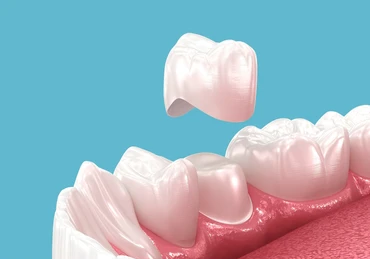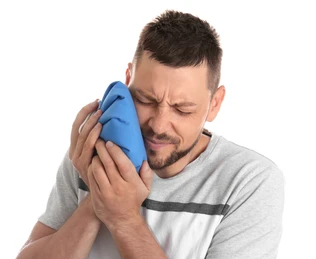
“Pain that persists beyond the expected healing period may indicate underlying issues such as nerve irritation or crown misfit. Early evaluation helps prevent complications.”At Evershine Dental Clinic, regarded as one of the best dental clinics in Chembur, Dr. Alisha Khan employs advanced diagnostic tools to accurately assess any discomfort related to crowns. With over a decade of experience, she combines gentle care, precision, and the latest techniques to provide personalized solutions.
Ready to uncover why that crown still hurts after 2 weeks? Let’s explore the causes and your options for relief.
Is it Normal for a Temporary Crown to Hurt After 2 Weeks?
Temporary crowns may cause some initial soreness or sensitivity, particularly in the first few days after placement. This is usually a result of gum irritation, changes in bite, or the tooth adjusting to the temporary covering. However, pain that continues for two weeks or more is not typically expected. At this point, it may signal complications such as pulp inflammation, crown misfit, or an issue with adjacent teeth or gums.
In many cases, patients describe pain under the crown or sensitivity when chewing or drinking hot or cold beverages. These symptoms may point to a deeper concern that requires professional examination. Contacting a qualified dentist is essential to determine whether an adjustment or further treatment is needed. Ignoring persistent discomfort could lead to worsening pain or even infection.
Experiencing discomfort after 2 weeks of temporary crown placement? Schedule an expert evaluation today.
Let’s pinpoint the common culprits behind that lingering crown pain.
Why Does My Crown Still Hurt After 2 Weeks?
Pain from temporary crown can persist for several reasons, including:
Pulp Inflammation: The procedure may irritate the tooth’s nerve, especially if decay is extensive. This can cause lingering sensitivity or sharp pain.
Crown Misalignment: If the temporary crown doesn’t fit well, it may place uneven pressure, affecting your bite and causing pain under the crown.
Bite Issues: A high spot on the crown can cause constant tooth contact, leading to jaw discomfort or tooth pain after dental crown placement.
Bruxism (Teeth Grinding): Nighttime grinding can strain the crowned tooth, causing pain over time.
Infection: In rare cases, bacteria may enter under the crown, leading to infection.
These issues need timely intervention to avoid worsening of symptoms.
How Long Until Crown Feels Normal?
Most patients adjust to a temporary crown within a week to ten days. During this time, it’s normal to feel slight pressure, sensitivity to temperature, or mild gum tenderness. These symptoms usually fade as your mouth adapts to the crown. Eating soft foods, avoiding extremes in temperature, and practicing good oral hygiene can speed up this adjustment period.
However, if discomfort lingers beyond two weeks or worsens, it’s essential not to ignore it. Pain during chewing, persistent sensitivity, or discomfort that wakes you at night may point to deeper concerns like a misaligned bite, exposed nerves, or even an early infection. Visiting a skilled dentist ensures your crown is assessed and corrected promptly.
Looking for simple ways to ease your discomfort? Try these expert-approved tips.
How to Manage Temporary Crown Pain After 2 Weeks
Rinse with warm salt water: This reduces gum inflammation, and calms irritated tissues.
Avoid chewing on the affected side: This prevents pressure from aggravating the pain or dislodging the crown.
Avoid hard or sticky foods: These can damage or pull off the temporary crown.
Use desensitizing toothpaste: It can relieve nerve sensitivity and reduce discomfort.
Use a cold compress: This can ease external swelling and numb pain.
Take over-the-counter pain medications: Drugs such as ibuprofen can ease inflammation—consult your dentist.
Wear a night guard: If you grind your teeth during sleep, a night guard can shield the crown and the adjacent teeth.
Go to your dentist for a bite adjustment: If your crown is too high or your bite is uneven, a professional can quickly fix it.
“Never ignore tooth pain lasting more than two weeks. It may seem minor now but could indicate a treatable dental concern.”
Conclusion
Temporary crowns guard your tooth until you receive the permanent one. Although some discomfort is unavoidable, pain that persists beyond two weeks is abnormal and requires a professional examination. Pulp sensitivity, crown fit, or bruxism are usually treatable with prompt attention.
At Evershine Dental Clinic in Chembur, we ensure that every crown is comfortable and works perfectly. Under the guidance of Dr. Alisha Khan, our patients receive empathetic, state-of-the-art dental services that cater to their requirements.
Experience dental care that prioritizes your comfort—visit a seasoned specialist for safe and effective solutions. Book a consultation now!
Frequently Asked Questions
Is it normal to have pain 2 weeks after temporary crown placement?
Persistent pain after 2 weeks is not normal and should be assessed.
Can a temporary crown cause nerve pain?
Yes, particularly if the pulp of the tooth is irritated or exposed during preparation.
Will the pain from the temporary crown go away on its own?
Mild pain might be, but ongoing pain usually requires the dentist’s attention.
How do I know if my temporary crown is infected?
Symptoms are swelling, aching pain, bad taste, or fever. Seek immediate attention.
Can a temporary crown come off because of pain or pressure?
Yes, too much pressure or a poorly fitting crown can cause it to be loose or come off.
Is jaw pain related to crown pain?
Jaw pain can occur if your bite is uneven or you grind your teeth when adjusting to the crown.
Will the temporary and permanent crown differ in terms of feeling?
Yes, the permanent crown will feel different than the temporary one since permanent crowns are fabricated especially for the best fit and comfort compared to the temporary ones.
Reference links:
Disclaimer: This page is for informational purposes and not for promotional use.



